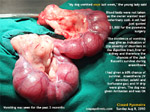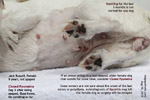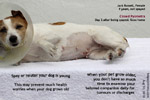Sunday,
August 8, 2010
Consultation at Vet 1.
The 9-year-old, 5-kg Jack Russell passed out
some sticky vaginal discharge and also blood
in the stools on Saturday. The young lady
and her brother googled "pet clinic" and
went to North-east Singapore.
Vet 1 shaved bald the dog's ventral area for
an abdominal ultrasound scan. "Lumps of
around 3 cm in diameter can be seen", he
told the owner. Vet 1 diagnosed pyometra
based on vaginal discharge, fever, abdominal
palpation and scan. Surgery and anaesthesia
quoted was $1,000.
The kind vet advised surgery as soon as
possible and presented the young lady a list
of vet practices in Singapore. She was
living in Toa Payoh and phoned me for a
quotation. I was surprised when she told me
that she did not know of Toa Payoh Vets
existed (since 1982) although she is a Toa
Payoh resident.
CHANCES OF SURVIVAL
It is difficult to guarantee 100% survival.
The dog had actually been vomiting
occasionally in the past 3 months, not just
last week.
Vet 1 gave a Rimadyl 0.5 ml (50mg/ml)
injection 2 hours ago. The temperature
before Rimadyl injection was 39.7 deg C
(fever). When I checked the dog 2 hours
later, it was 38.5 deg C (normal). So I had
to decide to operated soon as the fever
would return when the drug effect went off.
I gave an antibiotic (Baytril) 0.6 ml SC 1
hour before surgery. The dog was operated
and recovered well.
 She was still drowsy when the young lady and
her brother visited her 2 hours after
surgery but could recognise them. She was still drowsy when the young lady and
her brother visited her 2 hours after
surgery but could recognise them.
I showed the pyometra to the young lady and
her brother. "Vet 1 said it was 3-cm lumps,"
she said. "The ultra-sound cannot measure
all lumps accurately," I said. "Some of the
lumps in this uterine body are 3 cm in
diameter and some are more or less." I told
her. She was very relieved that her
dog was alive and that was what counted.
RIMADYL
(a class of pain-killer called NSAID).
1. I have never used Rimadyl before surgery
although the manufacturer (Pfizer's website)
does recommend it, at 2 hours before surgery
so that the dog will not feel any pain after
surgery.
2. The manufacturer advised the use of
parenteral fluids during surgery to reduce
the potential risk of renal complications
when NSAID is use perioperatively.
3. In this case, the first vet had given 0.5
ml Rimadyl (50 mg/ml) SC 2 hours ago and no
antibiotics. The dog had a fever of 39.7C.
When I was consulted 2 hours later, I
checked the temperature. It was 38.5C. The
owner commented that the dog looked better.
Rimadyl had reduced the pain. It also
appeared to be anti-fever too.
Calculation of dosage in this case.
Jack Russell, Female, 9 years old, 5 kg.
Manufacturer advised: 4.4mg/kg for 24 hours
or 2.2mg/kg two times a day by injection.
Same dosage for oral administration.
Therefore, the first vet gave 25 mg SC or 5
mg/kg.
 I decided to operate on the dog 2 hours
after consultation as the fever had subsided
and might return if there was a delay. The
dog growled after some time when I checked
her gums which were pink but dry-looking. I
could feel a large swelling in her lower 1/3
of the abdomen but not the lobes felt by the
first vet. She looked "pregnant". Rimadyl
might have made abdominal palpation
difficult. There was no pain reaction from
this Jack Russell. I decided to operate on the dog 2 hours
after consultation as the fever had subsided
and might return if there was a delay. The
dog growled after some time when I checked
her gums which were pink but dry-looking. I
could feel a large swelling in her lower 1/3
of the abdomen but not the lobes felt by the
first vet. She looked "pregnant". Rimadyl
might have made abdominal palpation
difficult. There was no pain reaction from
this Jack Russell.
Rimadyl provides pain relief and was already
given by the first vet during consultation.
I did not give anymore for the next 24
hours.
 SEVERE DRUG
REACTIONS ASSOCIATED WITH NSAIDs SEVERE DRUG
REACTIONS ASSOCIATED WITH NSAIDs
include gastrointestinal, renal and hepatic
signs and in rare situations, death.
Therefore, in pyometra post-surgery, I don't
give NSAID before or after
surgery as I don't know how badly damaged
the dog's kidneys are. This dog had been
vomiting for the last 3 months and would not
be considered healthy.
It is safer as the owner wants a dog
alive at the end of the surgery. |
 TOA
PAYOH VETS
TOA
PAYOH VETS TOA
PAYOH VETS
TOA
PAYOH VETS